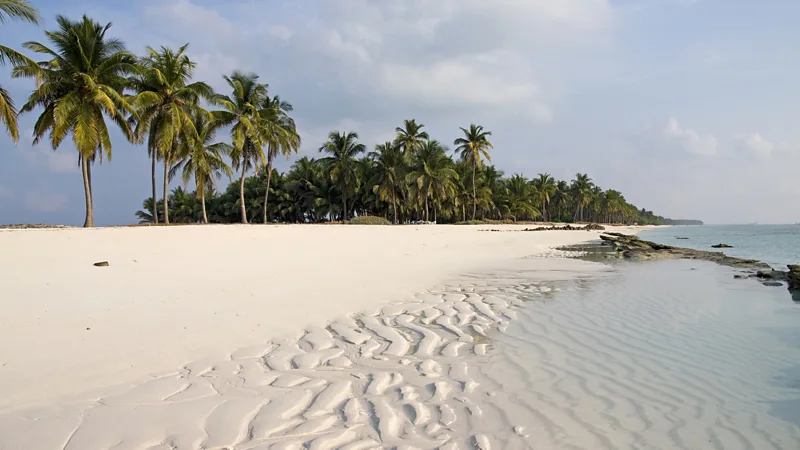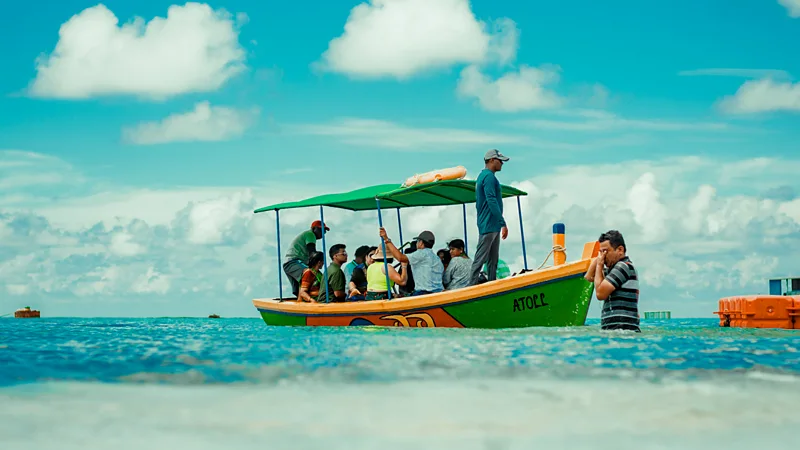India's wildly remote islands that are trending
 India's coral islands of Lakshadweep gained attention from tourists following a visit by Prime Minister Modi last month. However, concerns arise about whether the delicate environment of the islands can withstand the surge in tourism.
India's coral islands of Lakshadweep gained attention from tourists following a visit by Prime Minister Modi last month. However, concerns arise about whether the delicate environment of the islands can withstand the surge in tourism.
When approaching India's Lakshadweep archipelago in the Arabian Sea, about 490km west of Kochi, the vista reveals various shades of blue. Close to the white sandy beaches, coconut trees fringe light blue waters, transitioning to turquoise further out, and deepening to emerald in the open sea.
Geologist Shradha Menon, from the Indian Institute of Technology, describes the island's allure, having visited three times in the past two years for carbon sedimentation studies. Previously, flights from Kochi carried only a few outsiders among island residents and officials.
Prime Minister Narendra Modi's January 2024 visit to Lakshadweep sparked a surge in interest among Indian travelers. His shared photos and videos of the visit on social media platforms, encouraging others to experience the beauty of the islands.
Subsequently, Lakshadweep garnered significant attention, with Google searches reaching a two-decade high, as reported by The Economic Times. Media outlets published travel features, and online platforms like MakeMyTrip saw a remarkable increase in searches for Lakshadweep following Modi's visit.
Tourism Boom and Infrastructure Plans
The Society for Promotion of Nature Tourism and Sports (SPORTS), responsible for managing tourism in Lakshadweep, is experiencing unprecedented demand. Abdul Samad, one of SPORTS' water sports instructors, notes a significant increase in inquiries since Prime Minister Modi's visit, contrasting with previous levels of activity.  Cordelia Cruises, operating routes to Lakshadweep since September 2021, reports a staggering surge in booking queries following Modi's visit. Plans for new beach and water villas on islands like Suheli and Kadmat are already underway, with confirmation from Samad. Furthermore, Lakshadweep's mention in Finance Minister Neermala Sitharaman's budget speech indicates government attention towards enhancing island connectivity to foster tourism growth.
Cordelia Cruises, operating routes to Lakshadweep since September 2021, reports a staggering surge in booking queries following Modi's visit. Plans for new beach and water villas on islands like Suheli and Kadmat are already underway, with confirmation from Samad. Furthermore, Lakshadweep's mention in Finance Minister Neermala Sitharaman's budget speech indicates government attention towards enhancing island connectivity to foster tourism growth.
Lakshadweep, a small archipelago in the Arabian Sea, comprises 36 islands, including atolls, reefs, and submerged banks. Among these, 10 islands are inhabited, with a total population of approximately 70,000, primarily engaged in fishing and coconut farming. Unlike typical Indian beaches, Lakshadweep's pristine white-sand shores are distinctive. The name
"Lakshadweep," meaning "a lakh (100,000) islands" in Sanskrit, reflects its unique geological formation. Conservation director Vardhan Patankar explains that these atolls, remnants of ancient volcanoes, gradually sank to just above sea level, forming rings of corals that protect the islands. Patankar emphasizes that Lakshadweep, situated only a few meters above sea level, relies on coral reefs for protection against environmental threats.
Facing Disappearing Land and Coral Damage
 The Lakshadweep archipelago, like many other islands worldwide, faces the harsh realities of climate change. Coastal erosion has led to the disappearance of entire land masses, such as Parali 1 in Bangaram atoll in 2017. Over the past two decades, four significant temperature anomalies linked to the ENSO phenomenon have occurred, along with three devastating cyclones, resulting in extensive coral bleaching.
The Lakshadweep archipelago, like many other islands worldwide, faces the harsh realities of climate change. Coastal erosion has led to the disappearance of entire land masses, such as Parali 1 in Bangaram atoll in 2017. Over the past two decades, four significant temperature anomalies linked to the ENSO phenomenon have occurred, along with three devastating cyclones, resulting in extensive coral bleaching.
Scientists warn that, based on conservative estimates, Lakshadweep could be submerged by 2050. However, the situation could worsen with additional pressures from tourism, development projects, and industrial fishing. To mitigate the impact of rising tourist numbers, SPORTS plans to regulate visitors through a permit system and encourages cruise ships and yachts to visit, aiming to reduce overnight stays and minimize waste generation.
Despite these efforts, concerns remain about potential damage to the fragile coral reef walls by large ships, the environmental footprint of upscale villa construction, and increased commercial fishing to meet tourist food demands. Additionally, the development of resorts may exacerbate these issues, further threatening the delicate balance of the island's ecology.
Embracing Eco-Friendly Exploration in Lakshadweep
 For eco-conscious travelers, Lakshadweep offers a plethora of sustainable activities amidst its stunning natural beauty.
For eco-conscious travelers, Lakshadweep offers a plethora of sustainable activities amidst its stunning natural beauty.
Lakshadweep stands out as a premier destination for snorkeling and scuba diving in India, boasting shallow waters teeming with diverse marine life and vibrant coral reefs. According to Patankar, the underwater visibility is exceptional, providing an awe-inspiring experience for snorkelers and divers.
Underwater encounters may include snappers, groupers, moray eels, butterflyfish, black botched stingrays, and the captivating yellowmask surgeonfish, known for its color-changing journey to adulthood. Additionally, green sea turtles frequently grace the shores, adding to the island's allure.
Beyond the aquatic wonders, Lakshadweep offers enchanting views of the night sky, unhindered by light and air pollution. Visitors like Shalina CV have marveled at the abundance of stars, constellations, and shooting stars, describing the island as a tranquil haven where time seems to stand still, enveloped in a serene sense of calm.
Exploring Sustainable Adventures and Local Hospitality in Lakshadweep
 Night fishing presents an unmissable adventure for tourists, offering the chance to join fishermen on boat expeditions and engage in pole-and-line fishing, a method known for its minimal environmental impact. Skipjack and yellowfin tuna are among the prized catches awaiting eager participants.
Night fishing presents an unmissable adventure for tourists, offering the chance to join fishermen on boat expeditions and engage in pole-and-line fishing, a method known for its minimal environmental impact. Skipjack and yellowfin tuna are among the prized catches awaiting eager participants.
For those seeking more aquatic thrills, government-operated dive centers provide opportunities for kayaking, windsurfing, parasailing, and other water sports activities, ensuring an exhilarating experience while respecting the island's delicate ecosystem.
Travelers can opt for cozy accommodations at locally-run homestays, such as Abdul Rahman Homestay and Feroze Homestay on Agatti island, or Kinak on Kalpeni island. Additionally, some locals have established private tourism enterprises like Landiago, led by owner Shabab Ahmed, offering unique excursions to landmarks such as the Juma Masjid on Minicoy Island and historical lighthouses.
Booking experiences with local operators not only contributes directly to the economy of Lakshadweep but also allows tourists to benefit from the authentic insights and expertise of island residents. Patankar emphasizes the importance of empowering locals to safeguard the islands, expressing confidence that their stewardship is essential for preserving the natural beauty and ecological balance of Lakshadweep.
































































